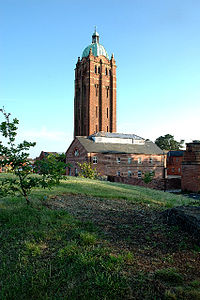- Northfield Hospital
-
The Northfield Hospital was a psychiatric hospital located at Tessal Lane, Northfield near Birmingham, England, and is famous primarily for the work on group psychotherapy that took place there in the years of the Second World War. Originally called the Rubery Hill and Hollymoor Hospitals, they closed in 1995.
Contents
Background
Therapeutic communities, as we know them today, developed from two visionary experiments between 1942 and 1948, known as the Northfield experiments (Harrison, 2000[1]). In 1942, Wilfred Bion from the Tavistock Clinic was placed in charge of the military training and rehabilitation wing of Northfield Hospital where he had to rehabilitate and return up to 200 men to the army. He used "group dynamics" to encourage the men to learn a way of coping and adapting to inter-group tensions. Although Bion and his colleague Rickman (Kraemer, 2011[2]) were successful in rehabilitating many patients, their approach was not appreciated in the prevailing military-oriented system and they were transferred.
The "first Northfield experiment", then, was led by Bion and was unsuccessful, in the sense that it had to close after 6 weeks. The ideas were, however, taken up and developed by others such as S. H. Foulkes, Rickman, Bridger, Main and Patrick De Mare. Army psychiatric services were faced with hundreds of psychologically traumatised soldiers and the expectation that they were to help as many as possible recover to a state where they could return to the front line. The psychiatrists at Northfield Hospital in Birmingham decided to focus on the unit as a whole rather than on individual problems; they structured the wards as communities, encouraging mutual support and cooperation in living (in some ways similar to life in the army), with non-directive group discussions to examine and understand the process. They saw the whole community as both the patient and the instrument of treatment, and the aim was the education and training of the community in the problems of neurotic defences and interpersonal relationships.
Foulkes went to Northfield in 1943 where he joined Harold Bridger, Joshua Bierer and Tom Main. They too made use of group psychotherapy but took care to integrate their approach into the overall treatment philosophy and hence were able to stay on, with much success. The "second Northfield experiment", led primarily by S. H. Foulkes, was therefore more successful and was based around the use of small psychotherapy groups on the hospital wards.
Hospital description
Northfield hospital refers to both the Rubery Hill and Hollymoor Hospitals in Northfield. Dr Thomas Lyle oversaw the building of Rubery Hill hospital which opened in 1882 and he was appointed as its first Medical Superintendent. Hollymoor Hospital was built as an annexe to Rubery Lunatic Asylum by Birmingham Corporation and opened 6 May 1905. During the 1914–1918 Great War, Rubery Hill was commandeered and became known as the 1st Birmingham War Hospital.[3][4]
During the Second World War, the hospital was again converted to a military hospital in 1940. In April 1942 it became a military psychiatric hospital and became known as Northfield Military Hospital.[4]
By 1949 the Hollymoor Hospital was recognisably distinct from Rubery Hill Hospital. It held 590 patients, falling slowly to 490 by 1984, and then dropping rapidly to 139 by 1994. The hospital closed in 1995 and was largely demolished.[4][5]
Notes
- ^ Harrison, T. ( 2000) Bion, Rickman, Foulkes and the Northfield Experiments. London: Jessica Kingsley
- ^ Kraemer, S. (2011) 'The dangers of this atmosphere’: a Quaker connection in the Tavistock Clinic’s development. History of the Human Sciences 24: 82-102
- ^ [1] THE OLD “DOCTORS HOUSE”] accessed Sept 2010
- ^ a b c http://www.bhamb14.co.uk/index_files/HollymoorHospital.htm Hollymoor Hospital] Birmingham History. Accessed september 2010
- ^ "Details: Hollymoor Hospital, Birmingham". Hospital records database. The National Archives. http://www.nationalarchives.gov.uk/hospitalrecords/details.asp?id=2113&page=28. Retrieved 13 September 2010.
External links
Categories:- Psychiatric hospitals in England
- History of mental health in the United Kingdom
- Hospitals in the West Midlands (county)
- Therapeutic community
Wikimedia Foundation. 2010.

